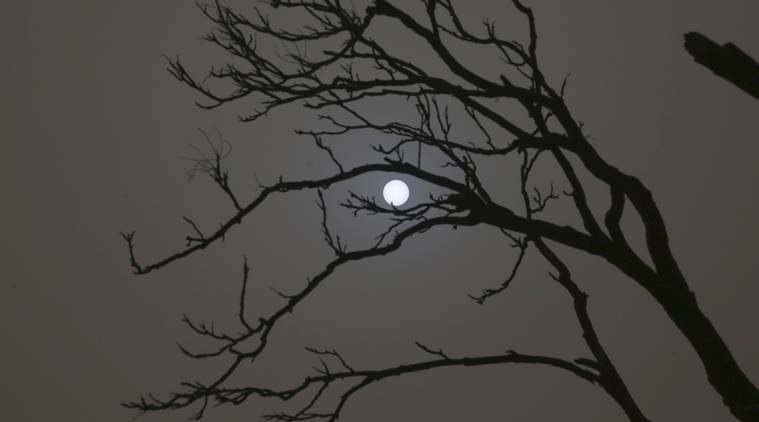- India
- International
Artemis in ancient Greece
Across cultures, earth’s closest neighbour has had an irresistible pull on the human psyche.
 Certainly, the moon, as imagined by many writers, is a friend to vampires and werewolves. (Express Archive)
Certainly, the moon, as imagined by many writers, is a friend to vampires and werewolves. (Express Archive)
You develop an instant global consciousness, a people orientation, an intense dissatisfaction with the state of the world, and a compulsion to do something about it. From out there on the moon, international politics look so petty. You want to grab a politician by the scruff of the neck and drag him a quarter of a million miles out and say, “Look at that, you son of a bitch”. – Edgar Mitchell, astronaut
There was a bright full moon, with heavy black, driving clouds, which threw the whole scene into a fleeting diorama of light and shade as they sailed across. – Bram Stoker in Dracula
For all scientific intents and purposes, the earth’s moon is an unremarkable natural satellite of a minor planet in a rather inconsequential solar system.
Yet, the moon has haunted the human imagination across cultures for thousands of years — seen as benign by some, a lovers’ muse by others, it’s been a symbol of fickleness and change (Romeo and Juliet), a cause of madness (“lunacy” comes from the latin word lunaticus meaning “moonstruck”), and has been viewed as an omen of death and destruction, by many traditions.
Certainly, the moon, as imagined by many writers, is a friend to vampires and werewolves. The poet Lord Byron’s friend John Polidori wrote The Vampyre (1816), in which Lord Ruthven — one of the first vampires in English literature — is laid out in the light of the full moon, after being shot at by bandits, and is restored by it. Vampires less sophisticated than the Anne Rice variety are said to be filled with the “hunger” when the moon is full as well as when there’s a blood moon. And it is on full-moon nights that werewolves morph from human to wolf.

Full-moon nights, with their aura of pale mystery, are as much a part of the atmospherics of mystery and Gothic fiction, as are dark, stormy (moonless) nights, with the howling wind and torrents of rain.
Among the more benign moon myths is the view held by some Chinese Daoists, that the Dao — that great interconnected energy field, which is unfathomable and underlies all things — is like the moon, which “gently influences” the tides of our oceans, without forcing them.
In Hindu mythology, Soma (Chandra) is the god of the moon, zipping around the world in a chariot drawn by white horses. Soma is also the Sanskrit word for the intoxicating elixir of immortality, and part of the substance of the moon. It is believed that when the gods drink soma to stay young and immortal, the moon wanes, having lost some of its essence.
Artemis (whose equivalent in Roman mythology is Diana) is the ancient Greek moon goddess of the hunt, who symbolises chastity and a need to protect her own space. When Actaeon, a young mortal hunter, surprises her bathing nude, she transforms him into a deer. Actaeon is then chased and killed by his own hounds, who fail to recognise him. Artemis-Diana is the patron goddess of female independence, a goddess icon for many feminists. The moon, by extension, has become a potent symbol of feminine power for many feminists.
Among the Algonquian peoples, one of the most populous and widespread North American native language groups, the moon moves out of wispy myth into a naming terminology with pragmatic relevance. Thus, there is the bright harvest moon, which allows farmers an extended period of light to harvest their crops. There is the hunter’s moon, that provides hunters sufficient light to stalk their prey. Other “moons” in Algonquian classification include the cold moon (winter), and the wolf moon (when wolves and other canines cluster together to bay the moon). These classifications are still used by most Americans.
For the African Fon people, Mawu is the goddess of the moon, bringing coolness, the welcome relief of the night, and all manner of abundance to the people. She is the archetypal Old Woman of the West, whose mate Liza is the god of daylight and heat.
Astronauts have their own stories. Some, like American astronauts Mitchell and John Glenn, have reported experiencing mystical and altered states in outer space. Many find the argument for god’s existence not just plausible but a lived reality in that zone. More importantly, as the Mitchell quote shows, the view of the earth from the moon puts all our pettiness in perspective. We can no longer play the “us and them” binary game. It might be a great idea to drag our political leaders a quarter of a million miles away, point to earth’s beautiful blue-green orb, and say, “See that! Now, put your issues and policies in perspective.”
In the end, though, as the writer Anaïs Nin once wrote, “We are going to the moon — that is not very far. Man has so much farther to go within himself.” Myths are but placeholders, “fingers pointing to the moon”, in the old Zen metaphor. The real journey is into the depths of the human psyche.
Raj Ayyar is visiting faculty (social sciences and humanities), IIIT-Delhi.This article appeared in the print edition with the headline’On a Dark, Stormy Night’
May 10: Latest News
- 01
- 02
- 03
- 04
- 05






































